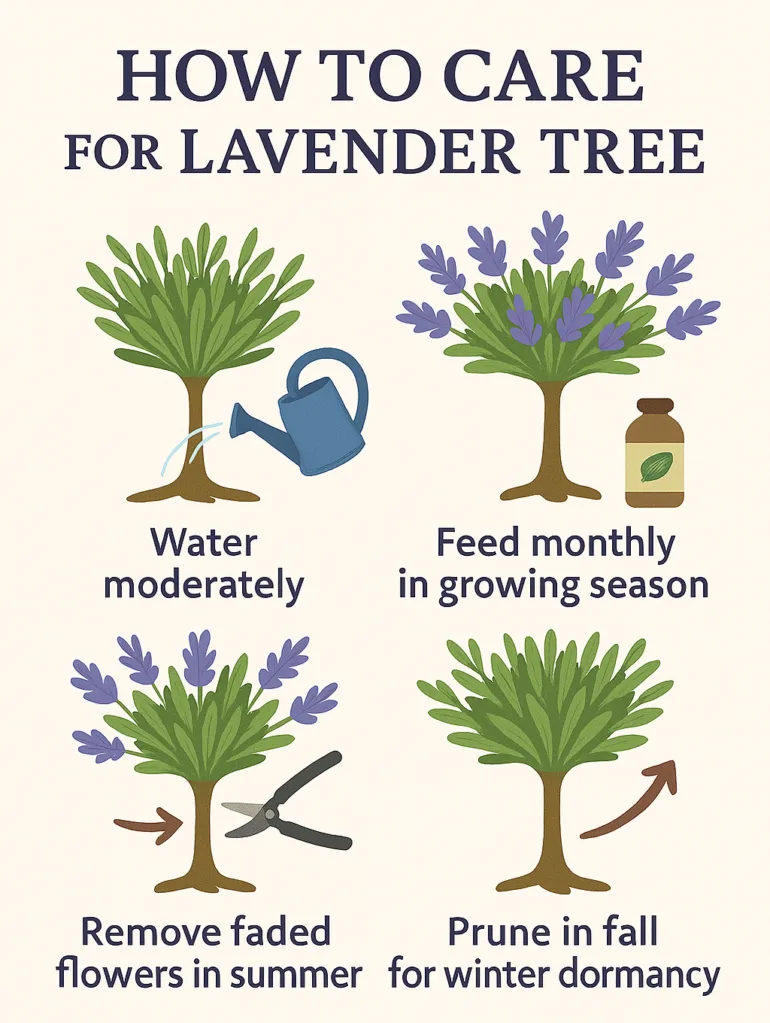If your garden (or balcony) is still without a plant that is elegant, durable and insanely photogenic at the same time – then it's time to get to know the lavender tree. This is not the lavender bush that we plant at the edge of the lawn. This is a selected, cultivated version – a true garden aristocrat. With a little skill and some patience, you can create something from a completely ordinary lavender that will convince even the most skeptical neighbor that you have a secret connection with the gardening mafia. So - How to grow a lavender tree from ordinary lavender
How from the usual lavender, grow a lavender tree? The very name Lavender (Lavender) takes us somewhere among the rolling hills Provence, where the air moves slowly, smells of herbs and time passes to the rhythm of crickets. But the good news is that you don't have to go to the south of France to get this feeling - all you need is a pot, a sunny corner and a little gardening spirit.
If you've only known lavender as a low, somewhat sprawling shrub along the garden path, it's time for an upgrade: lavender tree. An elegant take on the classic lavender that will add a sophisticated Mediterranean touch to your outdoor (or indoor) space. With a little perseverance and a few simple steps, you can grow it yourself – and you don't need a horticultural PhD.
Why a lavender tree?
First of all, because the lavender tree is beautiful. Its silhouette is light and structured at the same time, the canopy smells of summer, and the scent is more soothing than most meditation apps. But also from a practical point of view, it is an extremely grateful plant: it grows in a pot, does not need much water and loves the sun. And the neighbors will think you have a gardening consultant.
First thing: choose the right variety of “lavender tree”
It all starts with choosing the right species. For a tree, compact, aromatic varieties that are easy to prune and can withstand being potted are best.
- English lavender (Lavandula angustifolia): the most frost-resistant, ideal for planting outdoors or on a balcony that freezes in winter. It also has the most delicate and classic scent.
- French lavender (Lavandula dentata): slightly more delicate, but visually interesting, with slightly serrated leaves and a more exotic appearance. Suitable for warmer climates or indoors.
Choose young specimen with one main stem – it will be easier to shape it into a tree, not an overgrown bush.
Proper planting: it won't work without good drainage
Lavender doesn't like moisture. Its roots are like a lady in silk shoes – too much moisture and drama is guaranteed.
- Use a pot with holes in the bottom.
- Place a layer of gravel or expanded clay on the bottom of the container for drainage.
- Prepare a mixture of sandy, well-draining soil (ideally, something you would use for cacti or Mediterranean herbs).
Watering should be deliberate: not on a schedule, but based on the feel of the soil. If the soil is dry to the first knuckle, it’s time to water. If not – leave it alone. Too much water will cause root rot and a quick end to your botanical romance.

How to shape a lavender tree
Now for the part where the bush transforms into an elegant tree. This process takes some time and patience, but it's not complicated at all - it's more about regular care than science fiction.
Design process:
- Remove all side shoots near the base of the plant.
- Leave one main shoot that will form the “trunk”.
- When it grows to the desired height (30–50 cm), start shaping the crown.
- Regularly prune the top shoots to encourage branching and symmetrical growth.
- Remove faded flowers after each bloom - this will encourage new blooms and maintain the shape.
Think of a bonsai, only better smelling and less delicate. Prune like a hairdresser with vision: precise, regular and without mercy for unkempt branches.
Light and heat: the key to success
Lavender is a Mediterranean plant, which means it simply cannot do without sunlight. If you don't give it at least six hours of direct sunlight a day, it will quickly let you know that it's not the one. Without sunlight, growth will be slow, and the flowers will be more of a showpiece.
If your space doesn't have enough light, you might want to consider an additional plant light – or a different plant. Lavender doesn't handle the gray area between light and shade well.
Watering, feeding and general care

Once the plant is planted and growing nicely, all you need to do is follow a basic routine:
- Water moderately – better less than too much.
- Add a mild fertilizer for herbs or flowering plants once a month during the growing season.
- Remove faded flowers in summer to encourage new blooms.
- Prune the plant in the fall and prepare it for winter dormancy.
If it's in a pot, you can move it to a bright, cool place in the winter. If it's left outside, make sure to protect the roots and pot - bubble wrap will suffice.
A tree that is not just a decoration
Lavender tree It is not just a plant, it is part of the ambiance. It changes the atmosphere of a balcony or terrace, adding a sense of self-care, aesthetics and natural elegance. When you see the canopy you designed yourself in the morning while drinking coffee and inhale the familiar scent of lavender, you will wonder why you didn't try it before.
It doesn't take much. But what it gives back exceeds expectations – a fragrance that lingers in the air and the feeling that nature always finds a way to enchant.






